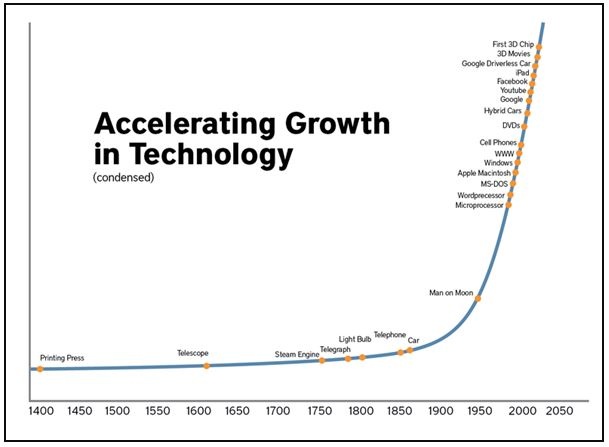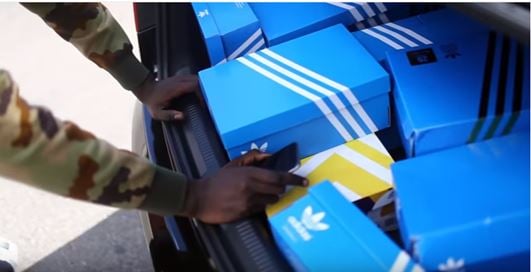The way we consume content is changing – a statement which will come as a surprise to no-one.
Things change, all the time – in fact pretty much everything in the digital landscape is changing at a rate never before experienced. Just check out this graph if you don’t believe me:

This is not just the trend in tech, but with digital media too – stats show that mobiles are now seen as the most important device for accessing the internet, 1 in 3 people are streaming TV to their mobile and that 9 out of 10 adults up to the age of 64 own a smart phone [source]. I want to talk about specifically is how brands have started to embrace this change in content consumption.
In particular, one of my favourite brands: Adidas.
In years gone by, Adidas like many other brands have used influencers – celebrities to me and you – in their marketing plans.

The concept was simple: find a person that millions of people like, slap your label on them, and get it seen wherever you can.
For decades brands have put images of our favourite celebrities in newspapers and magazines, propped up billboards around the country and showed us admired sports starts in adverts on our TV screens – and it worked. To this day, who doesn’t remember David Beckham ordering a Pepsi in that old Western bar, or Groucho Marx gracing the Frosted Flakes snippet in the daily newspaper? (Okay, maybe a bit too far back…)
Now of course brands still use this method, because it works for certain audiences; mainly your mum and dad, or that guy in your office that doesn’t have a phone because of one life decision or another.

A few sentences ago you may recall me saying that Adidas are one of my favourite brands. Two or three years ago I wouldn’t have said such a thing; they were just another brand to me, their marketing was exactly the same as every other big company. But then they got smart – I was within their demographic and they knew how to target their content right into my hands.
What Adidas did is identify new influencers outside of the typical sports celebrity. They realised that their customers and potential customers aren’t just interested in their products; they have lives outside of Adidas.
So who are they? Adidas’ customer demographic is between 15 and 30, and belongs to the upper middle, upper and lower upper class levels [source]. That means Adidas’ typical customers are tech savvy (own a smartphone and rely on it), and are engaged with current music.
{{cta(‘bcfbfeff-1f37-446e-ba29-6dcd0155aaec’)}}
Put those things together and you have digital platforms which belong to by present day musicians.
The likes of Stormzy, Pharrell Williams, Kanye West, 2 Chainz, B.o.B – the list goes on.
In short, Adidas realised that their customers are going to follow their brand ambassadors more on digital platforms than they are Adidas’ own digital content.
To put that in context, let’s say Adidas unveil a new shoe at their annual meet-up on their Snapchat story – what’s new, right? But instead let’s try Pharrell Williams taking over their Snapchat account and sharing images from the LA launch of his own Originals line, snapping the first glimpse of his purple HU NMD shoes – now that’s going to drive engagement. And it did.
The image of said shoes was saved by Snapchat users over 4,000 times using the app’s screenshot function, and later shared on other platforms including Instagram and Twitter. In total, the 128-second Snapchat story garnered 3.4 million views over 24 hours.
Pharrell’s audience is made up of the sporty teens Adidas wants – young digital natives who consume pop culture like a whale to krill. This audience doesn’t want curated, personalised content — they want immediacy and accessibility.
Silvia Calligher, global PR and social media director for Adidas Originals said:
“We didn’t know beforehand if it was the right thing to do. We really want to give users an inside look, to make it a priority to see Snapchat before every other channel.”
While other sportswear brands are tapping into the Snapchat audience of their ambassadors (Kylie Jenner at Puma being the best example), so far their content has been mostly behind-the-scenes fodder from photoshoots.
But Adidas Originals is going one further. Rather than creating its own content, it’s handing the reins over to the influencers themselves.
Stormzy, a UK grime artist springs to mind – one example being his Adidas shoe giveaway.

Stormzy (A.K.A Big Mike, A.K.A Stiff Chocolate) drove around the streets of London, giving away Adidas creps (shoes) to anyone who showed him proof that they had purchased his Wicked Skengman 4 EP, covering the day on his Snapchat story. He didn’t once make it remotely obvious that this was in partnership with Adidas; it would seem to the casual Snapchat viewer that he did this out of his own pocket.
Fast forward a few months, he then flew to Tokyo to film one of his latest songs, “One Take Freestyle”. Adidas of course spotted an opportunity and released a YouTube video from their own channel, where Stormzy met with notable fashion designer Nigo – who designed Adidas’ Nigo rage (shock).
The video served no advertising purpose, it just existed – here is the bio from the video itself: this short documentary film accompanies the collection’s lookbook, covering the grime heavyweight’s trip as well as an exclusive live performance in the bustling Japanese capital – the perfect backdrop for the experiences of two of the most important names in contemporary culture.
The trip was of course covered on Stormzy’s own Snapchat channel, and the whole digital experience was flooded with Adidas branding.

But of course, you don’t realise that at the time. All you know is that an artist whose content you actively enjoy is showing you an inside look at their life, whilst putting their own humorous spin on it and giving you sneak peeks at fresh content. This isn’t so much product placement as complete Digital Trojan marketing.
Here is what Silvia Calligher also said about ambassador marketing:
“When we work with brand ambassadors, there are obviously common values, but they also bring to the brand something it didn’t have before. For a long time we’ve been considered a retro brand. This mobile conversation helps us get in the moment in the now.”
So, how can you engage and grow your audience like Adidas – without the giant budget?
This is the idea behind our campaigns at theEword. We identify how audiences behave online, engage them with the right content in the right place at the right time and we keep them coming back for more.
Firstly you want to identify who your audience are. You can do this by using tools such as Google Analytics, or speaking to your sales team to break down the demographics of your customers, which you can then use to inform focus groups and email surveys to find out information such as where your audience spend their time online. Some questions you could ask are:
- What are your top 3 social media sites that you visit (in order?)
- What types of articles do you enjoy reading online?
- What is your go-to resource to keep up to date with your interests?
- What steps would you typically take online when purchasing X?
- Which of the following would you do when purchasing X?
- Use video reviews
- Ask family or friends
- Read testimonials
- Research news articles about the product
Simple questions like this can really help to inform your next annual marketing strategy, and shape it around being seen by the right people in the right places.
Find out how we can help you understand your audience in more detail by arranging a chat with our team. Just complete the form below and we’ll be in touch:


